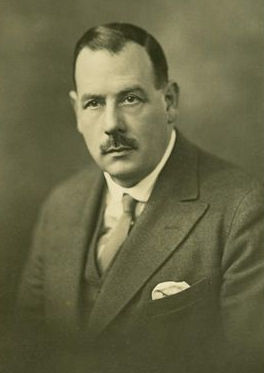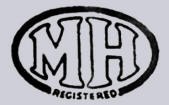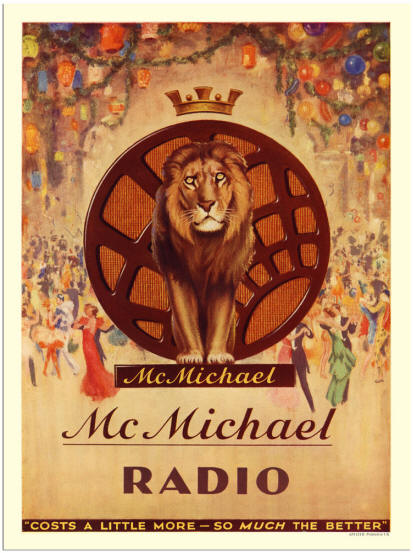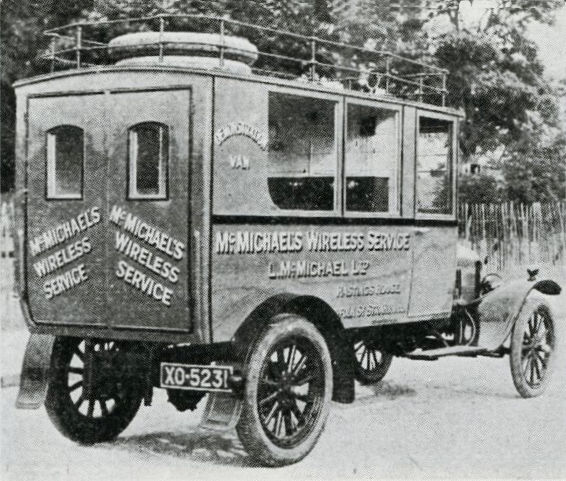|
|
|
|
|
Hubert
Leslie
McMichael
was born
in 1884 and
studied at
the
Technical College
Birmingham. During
World War I
he
worked at the Wireless
Instructional
Section
of
the Royal Flying Corps. |
 |
|
In 1913
he founded
the London
Wireless
Club with
a group of friends,
which eventually grew into
the
Radio Society of Great
Britain in 1922. |
|
In the middle
of
1920
McMichael as well as Benjamin
Hesketh
started
a
company. McMichael
sold
radio equipment which
was left over from
World War I,
books and magazines.
Hesketh
made
components, such as
resistors,
capacitors and coils. |
 |
In 1922
both companies were
merged to form
MH, McMichael
Hesketh. The
same year also saw the
first big
radio exhibition,
the All-British
Wireless
Exhibition. The
submission of
McMichael was particularly
large and
attracted strong
attention.
Wireless World magazine
devoted two
full pages to
the receivers, which
were described as "very
beautifully finished
and of
compact design." |
|
McMichael
presented the
MH1,
MH2, MH3
and
MH4, the number
indicating
the number of
valves. |
|
In 1923,
McMichael
introduced
the
MHRB (McMichael
Hesketh
Broadcast
Receiver),
specially
designed
for the consumer market
at the beginning
of the first
broadcasts
by the BBC. |

|
McMichael advertisement,
1933 |
|
In 1926,
McMichael
also
began
production
of
radio
equipment
for the
Navy. |
|
The first
portable radios,
like the Portable
Five
with 5
triodes,
were issued
in 1927. |
|
In 1928,
McMichael
introduced a full range of
high quality Dimic plug-in
coils. These coils
were
used
in
the
Screened Dimic
Three,
an "all
wave"
receiver, which was
also very popular in
the colonies.
In that year
also the
first
AC receiver appeared. |
|
At the end of 1930, McMichael
introduced the first radiogram. |
|
Although
McMichael
made
experimental
superheterodynes as
early as
the mid-20s,
it
took until
1933
before
they
started making
this
type of
receivers
for
the consumer market. |
|
Quality was
a major
driving force.
McMichael
made all the
parts themselves,
with the exception of
valves
and headphones. |
|
In 1936
the company began
with the development of
television,
an
activity that ended abruptly
after the outbreak of
the
Second World War.
During WWII
the company was
active
as a manufacturer of
bomb racks for aircraft
and WTII transceiver equipment
for tanks and other
military
vehicles. |
|
After the war,
McMichael
returned to the
consumer
market, and 1947,
at the
first
Radiolympia Radio
Show, introduced
a complete new series of
radios,
televisions
and
radiograms. |
|
McMichael
also
remained active
on the
professional market.
They
made
sonar
equipment for the Navy
and
the
Army. |
In 1951 Leslie McMichael died at
the age of 67.
|
|
The last
McMichael radios and televisions were produced
in 1955. In 1956
the company
merged with
the
Sobell Group
under the name
Radio
and Allied Industries
Limited. Radios and
televisions were
from that moment
on released under the
brand name
Sobell,
while
McMichael focused on
work
for the military and
equipment for universities. |
|
The first Engish satellite UK1,
launched in 1960, carried McMichael equipment. |
|
Radio and Allied Industries
Limited was taken over by General
Electric Company in 1961. |
The name
McMichael
Radio Ltd.,
was changed to
McMichael
Ltd. in 1963,
because the company
no longer
made radios.
|
|
|
|
 |
|
McMichael's
Wireless Service delivery van, 1923 |
|
|